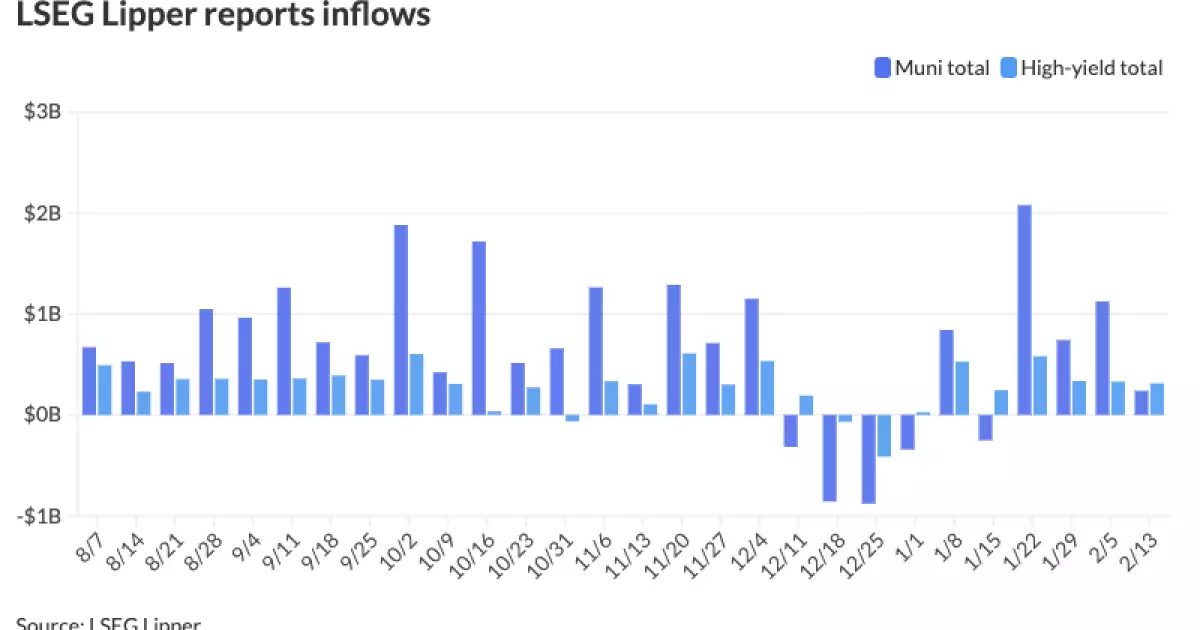The Resilience of the Municipal Bond Market Amid Economic Shifts

The municipal bond market recently exhibited a notable firmness as U.S. Treasury yields surged, marking a positive trend. On Thursday, the ratio of two-year municipal bonds to U.S. Treasuries was reported at 63%, while longer maturities demonstrated similar trends, with the 30-year ratio reaching 86%. This data, gathered from Municipal Market Data (MMD) and ICE Data Services, illustrates the ongoing dynamics within this niche market, which continues to operate effectively even amidst fluctuating economic conditions.
The resilience of the municipal bond market stands in stark contrast to broader economic sentiments. As various economic policies unfold, particularly those related to taxation and fiscal strategy introduced by the federal government, investor apprehensions occasionally mount. James Welch, a municipal portfolio manager, highlighted that the industry’s stability hinges significantly on policy decisions emanating from Washington. Although large-scale shifts in taxation and spending plans pose potential hazards, the municipal market has demonstrated an ability to withstand pressures such as tariff adjustments and budget negotiations.
Recent trends indicate an upsurge in municipal mutual fund inflows, which underscores investor confidence in this asset class. With a reported inflow of $238.5 million to municipal bond mutual funds in the week concluding Wednesday, the market has experienced an impressive string of four consecutive weeks of positive net flows. High-yield funds, in particular, have been a substantial contributor, capturing nearly $313 million during the same period. This explains a sustained interest in municipal bonds, even when compared to other investment vehicles.
This growing demand reflects a multifaceted investor approach, characterized by a blend of retail interest in both mutual funds and exchange-traded funds. Welch predicts that retail investors will remain a driving force going forward, especially as federal funding sources previously utilized in pandemic recovery programs wane significantly. The cumulative issuance year-to-date has surged to $50.74 billion, marking a substantial 12.5% increase from the previous year—evidence of the urgency many municipal issuers feel in addressing longstanding infrastructure needs that were postponed during the pandemic.
However, looming challenges also permeate the municipal bond landscape. Many jurisdictions are grappling with “deferred maintenance”—the backlog of projects that require funding but have been shelved due to insufficient resources during the pandemic. Without the sustenance of federal aid, municipal entities are increasingly compelled to seek fresh financing from the bond market, thereby intensifying competition and potential volatility.
Another contributor to the growing complexity of the municipal market is the active yield curve. Portfolio managers like Kim Olsan posit that the steep slope observed in the past decade is increasingly drawing investments away from cash-equivalent products. This pivot stems from a dynamic interest rate environment; for instance, the recent spike in the seven-day SIMFA rate serves as a cue for investors to reevaluate their holdings. Coupled with diminishing demand for tax-exempt money market balances, this shifting landscape signifies that the strategizing of income allocation is becoming more crucial for investors.
Issuance Trends and Market Reception
The primary market witnessed prominent activity on Thursday. A noteworthy issuance was the $1.209 billion in gas supply revenue refunding bonds by the Kentucky Public Energy Authority. Morgan Stanley notably facilitated this transaction, which included a variety of bonds maturing between 2025 and 2055. The diversity in tranche offerings reflects a strategic response to the heightened demand for municipal bonds, particularly in light of infrastructure and energy-related projects that need investor support.
In parallel, Barclays successfully priced over $854 million in airport system revenue bonds for the state of Hawaii, indicating strong investor engagement in the transportation sector. The breadth of these transactions illustrates a robust market appetite, encouraging issuers like the Tolleson Union High School District to enter with their own school improvement bond offerings as they position themselves to enhance educational facilities.
As we approach the latter part of the fiscal timeline, the municipal bond market’s ability to adapt and thrive in changing economic conditions remains to be tested. With sustained fund flows and active issuances, the prospects look favorable for municipal bonds—provided that stakeholders remain vigilant and responsive to potential policy changes emanating from the federal government. The balance between capturing investor interest effectively while navigating the challenges of deferred maintenance and evolving market dynamics will be critical as we move forward into the next fiscal period. Ultimately, the tangible commitment of both issuers and investors to this asset class underscores the enduring value of municipal bonds in a diversified investment portfolio.





